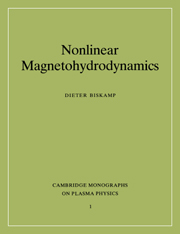Book contents
- Frontmatter
- Contents
- Preface
- 1 Introduction
- 2 Basic properties of magnetohydrodynamics
- 3 Magnetostatic equilibria
- 4 Normal modes and instability
- 5 Nonlinear evolution of MHD instabilities
- 6 Magnetic reconnection
- 7 MHD turbulence
- 8 Disruptive processes in tokamak plasmas
- 9 Dynamics of the reversed-field pinch
- 10 Solar flares
- Outlook
- References
- Index
7 - MHD turbulence
Published online by Cambridge University Press: 15 December 2009
- Frontmatter
- Contents
- Preface
- 1 Introduction
- 2 Basic properties of magnetohydrodynamics
- 3 Magnetostatic equilibria
- 4 Normal modes and instability
- 5 Nonlinear evolution of MHD instabilities
- 6 Magnetic reconnection
- 7 MHD turbulence
- 8 Disruptive processes in tokamak plasmas
- 9 Dynamics of the reversed-field pinch
- 10 Solar flares
- Outlook
- References
- Index
Summary
Ordinary nonmagnetic fluids are known to become turbulent at sufficiently high Reynolds numbers and a similar behavior is expected for electrically conducting magnetized fluids, though direct experimental evidence is scarce. Some confusion may arise, however, owing to the convention, widespread in the fusion research community, of calling the Lundquist number S = LvA/η the magnetic Reynolds number, the latter being correctly defined by Rm = Lv/η, where v is some average fluid velocity. S ≫ 1 simply means that the resistivity is small, while the system may well be nonturbulent, or even static corresponding to Rm ≃ 0. S is an important theoretical parameter characterizing growth rates of possible resistive instabilities. But only when large fluid velocities are generated in the nonlinear phase of an instability or by some external stirring Rm can become large, making the system prone to turbulence. MHD turbulence can thus be expected only in strongly dynamic systems, e.g. disruptive processes in tokamaks or flares in the solar atmosphere.
Though the behavior at Reynolds numbers close to the critical value, where the transition from laminar flow to turbulence occurs, has recently attracted much attention, the strongest interest is in the high-Reynolds-number regime, where turbulence is fully developed, which is characteristic of most turbulent fluids in nature.
- Type
- Chapter
- Information
- Nonlinear Magnetohydrodynamics , pp. 175 - 238Publisher: Cambridge University PressPrint publication year: 1993
- 2
- Cited by



